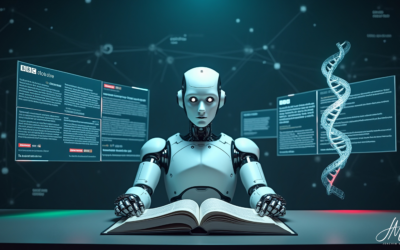The new EU AI Act presents companies with a key challenge, as Article 4 obliges them to ensure that employees have sufficient AI skills. Many companies are confronted with fundamental questions: Which AI skills are really necessary? How can the complex AI ecosystem be structured? Above all, which skills should be developed internally, and where does external expertise make sense?
The systematic development of these skills is becoming a strategic task due to the mandatory introduction of AI skills as part of the EU AI Act. Companies need a structured overview of the various skill levels – from the simple use of ready-made AI tools to the development of autonomous systems. This orientation is crucial to developing a sound AI strategy and making the right make-or-buy decisions for the systematic development of the required competencies.
The 7-level model of AI competencies
The successful implementation of AI technologies requires competencies that build on each other. Each level expands the possibilities of the previous one and enables more effective use of AI systems. The following model shows the seven levels of AI competence:
Level 1: Tool-based application (basics of AI use)
Level 2: Prompt engineering (optimization of AI interaction)
Level 3: Low-code and CustomGPTs (automation of AI processes)
Level 4: System integration (integration into company systems)
Level 5: Domain-specific fine-tuning (specialization of AI)
Level 6: AI development (own AI solutions)
Level 7: Autonomous systems (self-learning AI ecosystems)
Level 1: Tool-based application
Entry into AI use is achieved by understanding and using ready-made AI tools. A basic understanding of AI is crucial in order to achieve high-quality results and avoid typical beginner’s mistakes.
Practical examples:
- Creating marketing texts with Mistral
- Targeted image generation with FLUX
- Systematic processing of customer inquiries
- Transcribing and summarizing meetings
Requirements: ⭐
- Basic understanding of AI possibilities and limitations
- Knowledge of the most important AI tools and their areas of application
- Awareness of data protection and quality control
Level 2: Prompt engineering
This level teaches the basic competence to effectively control AI systems. The skills learned in this course are the basis for all further learning content and significantly determine the quality of AI results – from simple queries to complex AI systems.
Practical examples:
- Development of reusable prompt templates
- Structured analysis of complex documents
- Integration of company context in queries
- Systematic quality control of AI output
Requirements: ⭐⭐
- In-depth understanding of how AI works
- Ability to develop structured queries
- Experience in quality assurance of AI outputs
Level 3: Low-code and CustomGPTs
At this level, prompt engineering skills are used to create durable AI solutions. Visual development environments are used to create automated workflows and specialized AI assistants that perform recurring tasks in a standardized way.
Practical examples:
- Development of specialized AI assistants for specialist departments
- Automation of document processing
- Integration of various AI tools into work processes
- Creation of industry-specific workflows
Requirements: ⭐⭐⭐⭐
- Understanding of workflow automation
- Basic technical understanding of processes
- Experience with low-code platforms
Level 4: System integration
This area involves the expert integration of AI systems into the existing IT infrastructure. The focus is on the smooth connection of AI functions with company software and databases.
Practical examples:
- Integration of AI into CRM and ERP systems
- Development of automated data processing pipelines
- Development of AI-supported interfaces
- Implementation of security and compliance mechanisms
Requirements: ⭐⭐⭐⭐
- Sound IT system knowledge
- API and database expertise
- Understanding of system architecture
Level 5: Domain-specific fine-tuning
This level is about adapting existing AI models to the specific requirements of a company. Existing AI systems are trained and optimized with company data.
Practical examples:
- Training language models with specialist terminology
- Optimization of AI for industry-specific tasks
- Development of specialized AI analysis models
- Adaptation of AI systems to company guidelines
Requirements: ⭐⭐⭐⭐
- Expertise in machine learning
- Experience with model training
- Deep understanding of the specialized domain
Level 6: AI development
At this level, independent AI solutions are developed that address specific business requirements and cannot be covered by existing systems.
Practical examples:
- Development of customized AI algorithms
- Creation of specialized machine learning models
- Implementation of AI-driven decision-making systems
- Development of hybrid AI architectures
Requirements: ⭐⭐⭐⭐⭐
- Comprehensive AI development expertise
- In-depth programming knowledge
- Experience in system architecture
Level 7: Autonomous systems
The highest level of development involves the creation of self-learning AI ecosystems that can make decisions independently and continuously improve themselves.
Practical examples:
- Development of self-optimizing production systems
- Implementation of AI-controlled trading systems
- Development of autonomous logistics networks
- Creation of adaptive AI security systems
Requirements: ⭐⭐⭐⭐⭐
- Research level in AI development
- Expertise in distributed systems
- Deep understanding of reinforcement learning
Make-or-buy: strategic decisions for each skill level
The decision between in-house development and purchasing AI skills is complex and must be evaluated separately for each level, with strategic importance, available resources, and time requirements playing a central role.
The following decision criteria must be considered according to the respective level.
Basic levels (1-3): Internal core competencies
Make:
- Systematic training of all employees in AI basics
- Development of prompt engineering expertise
- Development of custom GPTs and team AI assistants
Buy:
- Initial training by external experts
- Best practice workshops
- Advice on initial implementations
Recommendation: Primarily internal setup with targeted external support for rapid skills development
Advanced levels (4-7): Specialized expertise
Make:
- Only if strategically necessary
- If AI is part of the core business
- For high security/compliance requirements
Buy:
- Specialized development partners
- Cloud service provider
- AI platform provider
Recommendation: The focus should be on “Buy”, while “Make” should only be used in strategically important core areas.
Conclusion
Building up AI expertise is not an option for companies, but a strategic necessity. The seven levels presented offer a structured way to systematically develop these skills. This is evident:
The first three levels – from basic AI usage and prompt engineering to CustomGPTs and low-code solutions – should be built up as internal core competencies. These form the foundation for all further AI activities in the company.
By contrast, a buy strategy is usually recommended for the higher levels, unless AI is part of the strategic core business.
The time for experimenting with AI is over. The focus is now on the systematic and strategically well-thought-out development of AI skills as a key factor for the future viability of companies.






